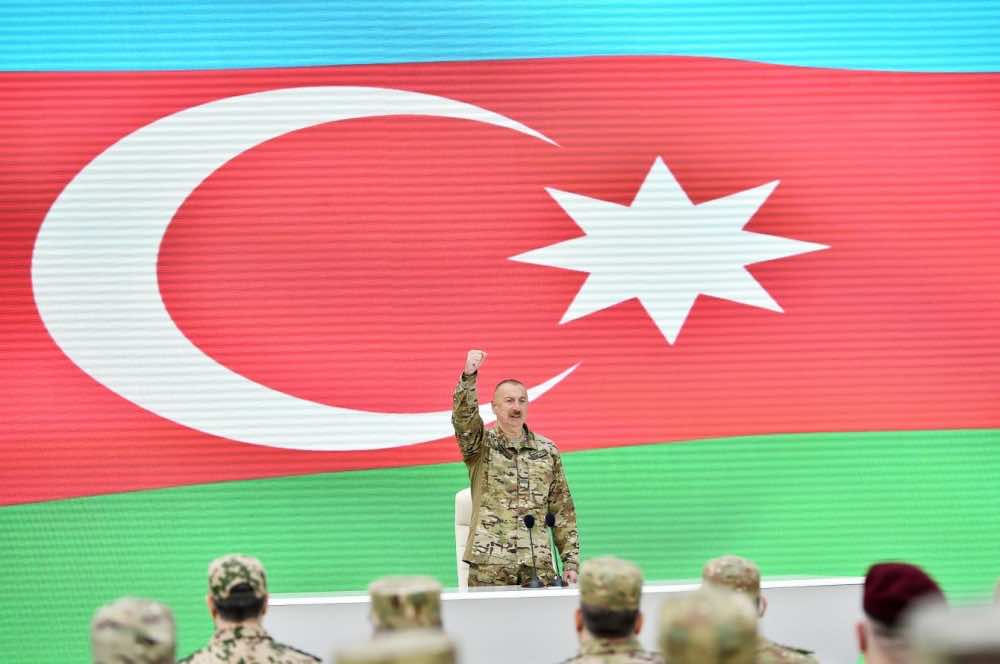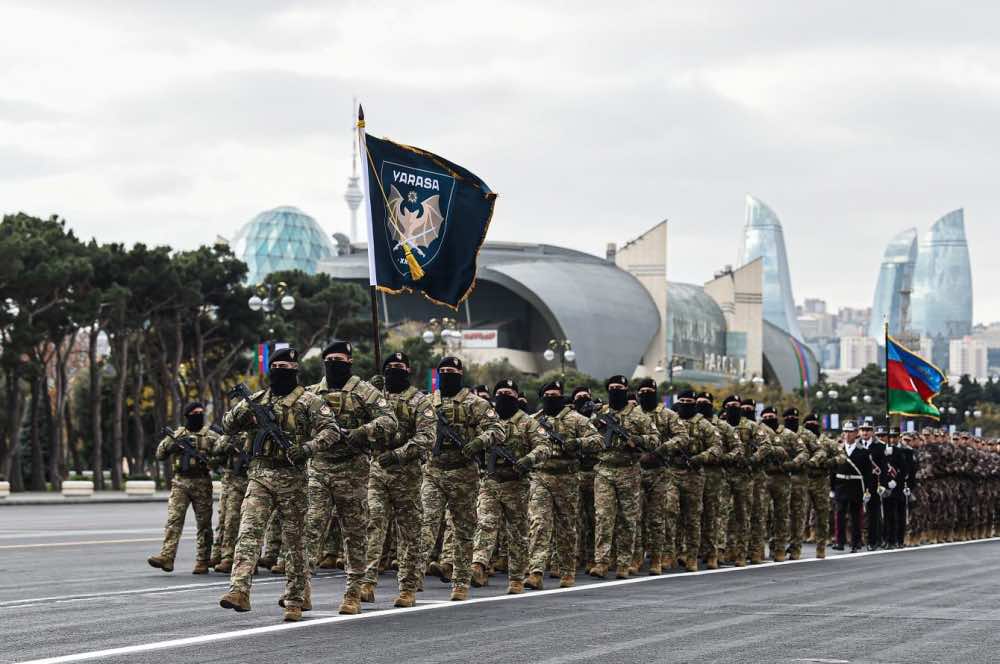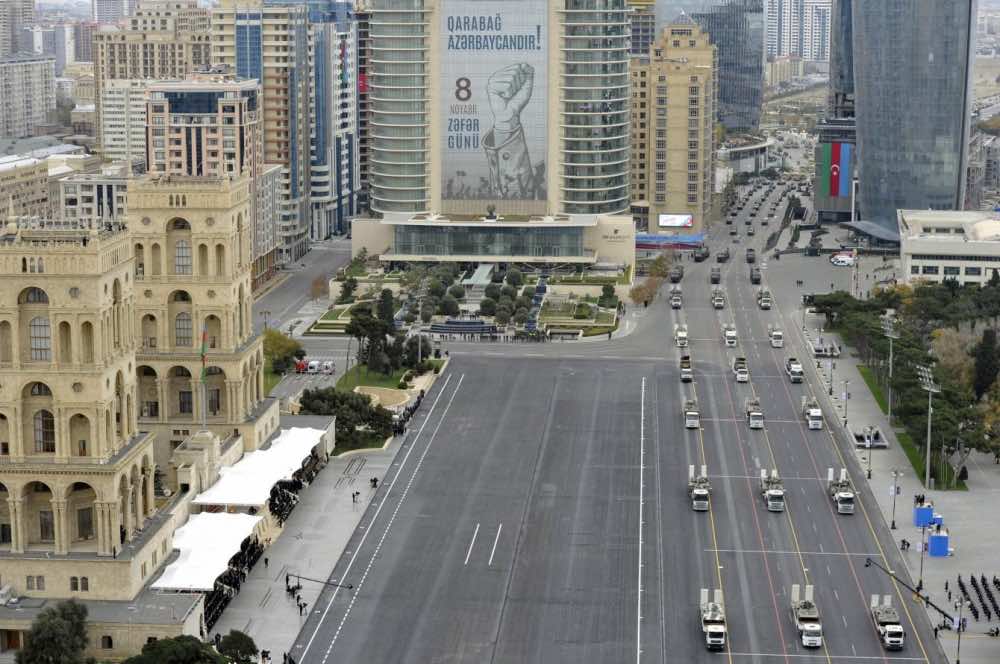Armed Forces Day of the Republic of Azerbaijan
 The foundation of the Internal Troops of the Republic of Azerbaijan was laid by the Parliament of ADR (Azerbaijan Democratic Republic), the first Democratic Republic in the East in 1919. It was decided at the meeting of the State Committee of the Democratic Republic of Azerbaijan on 10 June 1919, to organize a military service for the citizens of Baku and people living in the territories of its districts.
The foundation of the Internal Troops of the Republic of Azerbaijan was laid by the Parliament of ADR (Azerbaijan Democratic Republic), the first Democratic Republic in the East in 1919. It was decided at the meeting of the State Committee of the Democratic Republic of Azerbaijan on 10 June 1919, to organize a military service for the citizens of Baku and people living in the territories of its districts.
The Declaration of Independence of the Azerbaijan Democratic Republic adopted on May 28, 1918 stated that Azerbaijan had to have a strong and disciplined army, create its own armed forces in order to be able to defend itself against any foreign invasion and neutralize its enemies within the country. Because the country’s statehood that has no an independent army will always be threatened. Due to this need, General Khosrov bey Sultanov was appointed Minister of Defence in the first cabinet established on 28 May 1918.
On 19 June 1918 the ADR government, forced to fight against the occupation policies of both Armenians and Bolsheviks, in view of the very tense conditions in the country, declared martial law throughout the territory of Azerbaijan. On June 26, 1918, it was decided to establish the first military unit-separate corps with the status of a division in Azerbaijan. This decision gave the legal opportunity to the first democratic government of the Muslim East to establish its own national army. During 1918-1920 under the leadership of our outstanding generals Samad bey Mehmandarov, Aliagha Shikhlinski and other professional militaries the first units of national army with high combat readiness, military training and discipline were formed in Azerbaijan.
On 1 August 1918 the Military Ministry of the ADR was established. On December 26th, 1918 Samad bey Mehmandarov, a Liuetenant General of the Russian Artillery who had served in the Russian Army, was appointed as the Minister of Defence, with Lieutenant General Aliagha Shikhlinski appointed as his deputy on the 29th of the same month, and Lieutenant General Suleyman Shulkevitch as the Chief of the General Staff. The National Army, together with the Islamic Army of the Caucasus (which was a military unit of the Ottoman Empire formed on July 10, 1918), liberated Baku and its surroundings from the Armenian-Bolshevik occupation in a short period of time. These military units showed high competence in suppression of rebellions in Mughan and Asgaran, defeated units of Armenian regular army which violated Azerbaijani territorial borders near Gazakh. It was at the time when Azerbaijani army included such generals as Huseynkhan Nakhchivanski, Ibrahim Agha Usubov, Hamid Gaytabashi, Kazim Gajar, Javad bey Shikhlinski and Habib bey Salimov.
 The year 1919 was a decisive stage in the building of the National Army. The process of establishing the army was essentially completed in January 1920. The regular army of forty thousand included thirty thousand infantry and ten thousand cavalry units.
The year 1919 was a decisive stage in the building of the National Army. The process of establishing the army was essentially completed in January 1920. The regular army of forty thousand included thirty thousand infantry and ten thousand cavalry units.
However, after the fall of the Azerbaijan Democratic Republic the process of army building in our country stopped, and only after the great leader Heydar Aliyev came to power in 1969, due to his exceptional merits, the process of military training in our country became widespread. During the period of Heydar Aliyev’s leadership in the republic, the issues of army building and training of military personnel were brought to the forefront. In 1971, as a result of serious efforts, Heydar Aliyev managed to establish a military lyceum in Azerbaijan named after prominent general Jamshid Nakhchivanski. The national leader also managed to help Azerbaijani young men to get into the Baku Higher Combined Arms Command School and Baku High Navy School, as well as to other military schools throughout the USSR on preferential terms. Thus, 20 years before Azerbaijan gained independence national leader Heydar Aliyev provided the high-level basis for training of the national military personnel. After the independence was gained this military school was indeed the basic support to the formation of the national army.
At the end of 1991, as a result of the collapse of the USSR, newly independent Azerbaijan found itself in a difficult socio-political situation. The decision on the establishment of the Defense Ministry of the Republic of Azerbaijan was adopted on September 5, 1991. The Supreme Council of the Republic of Azerbaijan adopted the Law on the Establishment of the National Army on October 9, 1991. But the Azerbaijani leadership made no serious effort to implement these documents. The country was gripped by chaos and anarchy.
When national leader Heydar Aliyev returned to power at the insistence of the people on 15 June 1993, the situation in the country was extremely complicated. Important steps were taken towards army building. The Agreement on Cease-fire and Cessation of Hostilities in the area of the Azerbaijan-Karabakh conflict came into force on May 12, 1994. It was this very date which became a benchmark for formation of the national army of Azerbaijan. Special attention was paid to improving the material and technical resources of the armed forces, to the moral and psychological training of the servicemen, increase of their military spirit and nurturing patriotism. The 26th of June has been announced as the Armed Forces Day in accordance with the Decree of the President of Azerbaijan Heydar Aliyev dated May 22, 1998.
 As a result of the sagacious policy pursued by the national leader Heydar Aliyev, Azerbaijan’s close and effective cooperation with NATO since the mid-1990s played a key role in improving the army building process. This has led to improvements in the army building process, the modernisation of our Armed Forces and their adaptation to the generally accepted modern international standards.
As a result of the sagacious policy pursued by the national leader Heydar Aliyev, Azerbaijan’s close and effective cooperation with NATO since the mid-1990s played a key role in improving the army building process. This has led to improvements in the army building process, the modernisation of our Armed Forces and their adaptation to the generally accepted modern international standards.
Under the leadership of President Ilham Aliyev, the army building process in independent Azerbaijan has entered an entirely new phase in its history. Thanks to the purposeful policy of Victorious Commander-in-Chief, President of the Republic of Azerbaijan Ilham Aliyev, who successfully continues the political course of the national leader, Azerbaijan is achieving new success in strengthening and development of army building. In this connection steps have been taken to improve the professionalism of servicemen as well as the combat and moral-psychological training of servicemen, and provide our Armed Forces with the most modern weapons and equipment. As a result of this attention and care, the Armed Forces of Azerbaijan have in a short period of time become the strongest army in the region.
Our Armed Forces have proved their strength on the battlefield during the Patriotic War. The glorious victory won by our valiant Army in the Patriotic War that began on 27 September 2020 has been engraved in gold letters in our history. Under leadership of the victorious Supreme Commander-in-Chief our army dealt a crushing blow to the enemy and liberated 5 cities, 4 settlements and 300 villages from the occupation within 44 days. Combat experience and tactics of the Azerbaijani Army in the 21st century war, in particular the Shusha operation is studied today in military schools of the most advanced countries.
In the post-war period, important steps have been taken to further strengthen the Azerbaijani army, supply arms and ammunition, and create commando units.
Today, the heroic soldiers and officers of our army, who made the thirty-year dream of our people come true, have risen like an iron fist to defend and protect our liberated territories from occupation.
Recommended literature:
- Görüryılmaz, Mustafa. Türk Qafqaz İslam Ordusu və ermənilər : 1918 / M. Görüryılmaz ; red.: H. Öztürk, A. Ağaoğlu. - Bakı : Qismət, 2008. - 408 s.
- Süleymanov, Mehman Sirac oğlu. Azərbaycan Xalq Cümhuriyyətinin hərb tarixi / M. S. Süleymanov ; elmi red. P. Q. Darabadi ; rəy. N. Ə. Maksvell. I cild. - Tehran : Firuzan, 2014. - 760 s.
- Süleymanov, Mehman Sirac oğlu. Azərbaycan Xalq Cümhuriyyətinin hərb tarixi / M. S. Süleymanov ; elmi red. P. Q. Darabadi ; rəy. N. Ə. Maksvell. II cild. - Tehran : Firuzan, 2014. - 696 s.
- Süleymanov, Mehman Sirac oğlu. Azərbaycan ordusu: 1918-1920 / M. S. Süleymanov ; elmi red. P. Q. Darabadi. - Bakı : Hərbi Nəşriyyat, 1998. - 488 s.
- Süleymanov, Mehman Sirac oğlu. Azərbaycan Ordusunun tarixi / M. S. Süleymanov ; elmi red.: A. Ə. Paşayev, P. Q. Darabadi ; Azərbaycan Respublikası Silahlı Qüvvələrinin Hərbi Akademiyası. I cild : 1917-1918. - Bakı : Maarif, 2018. - 732 s.
- Süleymanov, Mehman Sirac oğlu. Azərbaycan Ordusunun tarixi / M. S. Süleymanov ; elmi red.: A. Ə. Paşayev, P. Q. Darabadi ; Azərbaycan Respublikası Silahlı Qüvvələrinin Hərbi Akademiyası. II cild : noyabr 1918 - aprel 1920. - Bakı : Maarif, 2018. - 725 s.
- Süleymanov, Mehman Sirac oğlu. Azərbaycan Ordusunun tarixi / M. S. Süleymanov ; elmi red.: M. Quluzadə, H. İ. Məmmədova ; Azərbaycan Respublikası Silahlı Qüvvələrinin Hərbi Akademiyası. III cild : 1920-1922. - Bakı : Maarif, 2018. - 784 s.
- Süleymanov, Mehman Sirac oğlu. Azərbaycan Ordusunun tarixi / M. S. Süleymanov ; elmi red.: M. Quluzadə, H. İ. Məmmədova ; Azərbaycan Respublikası Silahlı Qüvvələrinin Hərbi Akademiyası. IV cild : 1923-1990. - Bakı : Maarif, 2018. - 800 s.
- 44 gün Vətən Müharibəsi: Hulusi Kılıç informasiya cəbhəsində / ideya müəl. G. Yaz ; red. C. Qədir. - Bakı : XAN nəşriyyatı, 2021. - 152 s.
- Zəfər yolu. - Bakı : Qanun, 2020. - 340 s.
- Vətən müharibəsi tarixi: şəxsiyyət faktoru: 27 sentyabr - 10 noyabr 2020-ci il / Bakı Şəhər İcra Hakimiyyəti, AMEA A.A. Bakıxanov adına Tarix İnstitutu ; layihənin rəh., ön sözün müəl. E. Əzizov ; elmi red. K. Şükürov. - Bakı : Şərq-Qərb, 2021. - 444 s.